Research Article - (2021) Oral and Systemic Health
Influence of Type of Personality and Bruxism in Children
Deepa Gurunathan1*, Mahesh Ramakrishnan2, Joyson Moses3, Nivedhitha MS4 and Meghana Reddy J5
*Correspondence: Deepa Gurunathan, Department of Pedodontics, Saveetha Dental College and Hospitals, Saveetha University Tamilnadu, India, Email:
Abstract
Bruxism is a repetitive jaw-muscle movement characterized by grinding or clenching of teeth in an unconscious manner while awake or in sleep. Bruxism is mostly found in children aged between 3-10 years, it gradually reduces with increase in age. Bruxism has a multifactorial etiology, which includes morphological, pathophysiological and psychosocial factors. Psychosocial factors include anxiety, stress and characteristics of personality. The aim is to do a survey on the influence of personality and bruxism in children. The questionnaire-based study was carried out among parents with children between the ages of 1-17 years. The questionnaire comprised 15 questions which were used to detect the personality changes of children with bruxism. The questionnaire was uploaded on to an online survey platform (google forms) and the link was shared to the parents. Results show that 39.5% of the parents were aware about the clenching habits of their children and 60.47% parents were not aware. 60.5% clenched their teeth during the night whereas only 30.2% children were clenching their teeth due to stress and 9.3% clenched their teeth during the day. 23.3% of the children who clenched their teeth during stress mostly played on their own and 18.6% of the children who clenched their teeth played with a group of friends this shows the trait called extraversion. 39.5% of the children were worried this shows the trait called Neuroticism , 41.9% were dependent on their parents for work this shows the trait called Conscientiousness, 41.9% of the children who clenched their teeth during stress were responsible this shows the trait called agreeableness and 25.6% of the children were interactive with others. Within the limits of this study it is conclusive that personality traits are important factors that influence bruxism among children.
Keywords
Bruxism, Clenching, Personality
Introduction
Bruxism is a repetitive jaw-muscle movement characterized by grinding or clenching of teeth in an unconscious manner while awake or in sleep [1,2]. But this condition is more commonly observed during sleep, in which case it is considered as sleep movement disorder (sleep bruxism) [3]. Bruxism can cause severe attrition which results in shorter teeth, or fractured, and clenching increases the pressure on the mandible which strains the muscles, tissues around the jaw. This leads to orofacial pain, attrition, abfraction of teeth, degenerative temporomandibular disease, muscular hypertrophy, periodontal tissue injury and headache [4,5].
Bruxism is mostly found in children aged between 3-10 years, it gradually reduces with increase in age [6,3]. It is uncertain on how Bruxism starts, there are various physical and psychological causes affecting bruxism. Allergic reaction by asthma and respiratory airway infection may cause Bruxism by resulting in a reflex of the central nervous system [7]. It is mostly believed that children with bruxism develop this habit because of the influence of emotional factors, such as having to deal with various tasks, expectations, conflict, self-image, self-esteem, and anxiety [8] The capacity to deal with stress is unique to each individual and may be directly related to the formation of individual personality [9].
Bruxism has a multifactorial etiology, which includes morphological, pathophysiological and psychosocial factors. Psychosocial factors include anxiety, stress and characteristics of personality [10]. Feelings of frustration, anxiety or fear may trigger tooth clenching. According to Manfredini et al. [11], bruxism is related to repression of aggressiveness. Bruxers present higher levels of hostility, depression and susceptibility to stress [12].
Due to its multifactorial nature, it is important to establish the diagnosis of bruxism based on the possible etiological factors of this condition. This way, the identification of behavioral problems and emotional stress may improve the understanding of the interaction of these factors in the development or worsening of bruxism. Each child has different abilities and all the children are not capable of doing the same tasks [13]. Personality of the child influences the performance of the tasks. Personality traits are mostly related to individual ways of dealing with different situations, traits of neuroticism may result in anxiety and anger, whereas, conscientiousness is expressed through selfdiscipline and a sense of duty [14]. Personality traits developed in childhood are generally carried into adulthood. Depending on the various personality traits present during childhood, the child may have difficulty dealing with pressure and conflict and subsequently they may suffer from stress. Personality traits can also be associated with physical health such as nutritional disorders and sleep disturbance [15]. Our department is passionate about child care, we have published numerous high quality articles in this domain over the past 3 years [16-28]; Ramakrishnan, Dhanalakshmi and Subramanian, [29-32].With this inspiration we planned to pursue research on the influence of type of personality on bruxism in children.
The questionnaire-based study was carried out among Parents with children between the ages of 4-10. The questionnaire comprised 15 questions, which were used to detect the personality changes of children with bruxism. The questionnaire was prepared and approved by the scientific review board of the institution. The questionnaire was uploaded on to an online survey platform (google forms) and the link was shared to the parents. The questionnaire was just a screening questionnaire and cannot be used for diagnostic purposes.
Materials and Methods
Part 1 of the questionnaire was developed to include questions about the child’s age and sex. Part 2 of the questionnaire was developed to include questions about clenching of teeth, jaw pain after waking up in the morning and if the parents were aware of the various treatment options available for bruxism.
Part 3 of the questionnaire was concerned with the personality. The questions were taken from the big five standardized personality test. The main five components of the personality scale are extraversion, neuroticism, conscientiousness, agreeableness and openness.
Based on the responses from the subjects, the statistics was done and the results were obtained in a systematic manner. The statistics was carried out using the IBM SPSS software.
Results and Discussion
The total number of responses were 85, the age of the participants ranged from 1 to 17 years (Figure 1) where 48.8% of the participants were in the age group 5-8 years. Out of the total participants 55.8% were females and 44.2% were males (Figure 2). 39.5% of the parents were aware about the clenching habits of their children and 60.47% parents were not aware (Figure 3). 60.5% clenched their teeth during the night whereas only 30.2% children were clenching their teeth due to stress and 9.3% clenched their teeth during the day (Figure 4).
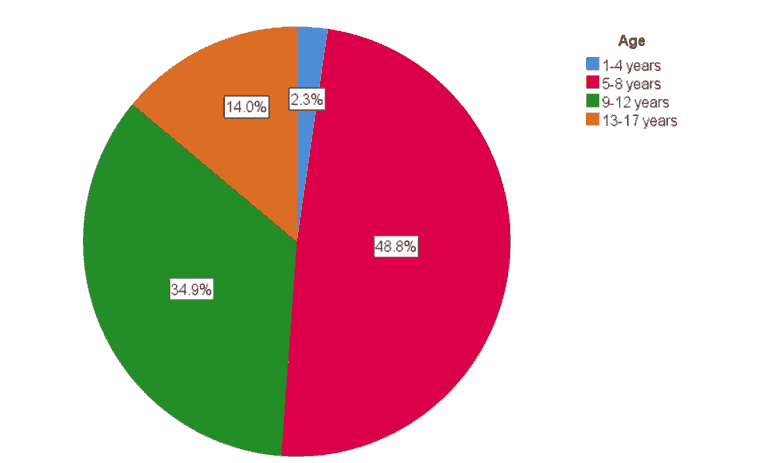
Figure 1: Pie chart showing the age of the children in this study (Blue represents 1-4 years, red represents 5-8 years, green represents 9-12 years, and orange represents 13-15 years). The highest number of participants were from the age group 5-8 years with 48.8%

Figure 2: Pie chart showing the gender of the children in this study (Blue represents Female participants and red represents male participants). The most common gender noticed in the survey was females with 55.8%.
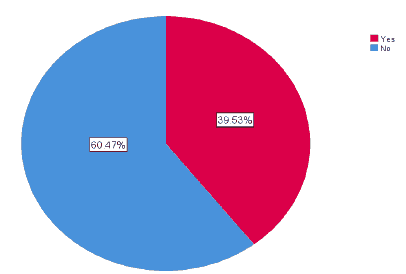
Figure 3: Pie chart showing parents response to the incidence of clenching in children where red colour represents yes and blue colour represents no. 60.47% of the parents did not notice any parafunctional activity.
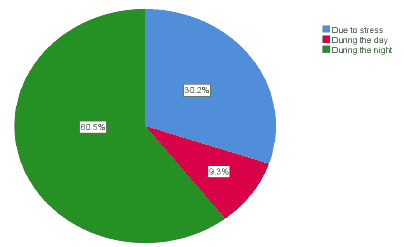
Figure 4: Pie chart showing the time period of clenching of teeth where blue represents clenching of teeth under stress, red represents clenching during the day and green represents clenching during night. Most participants clenched their teeth during the night (60.5%).
The incidence of jaw pain after waking up was seen in 50% of the participants and 40.5% of the participants did not have any pain (Figure 5). 39.5% of the parents were aware about the various treatment options available, 32.6% were not aware and 27.9% had a vague idea about it (Figure 6).
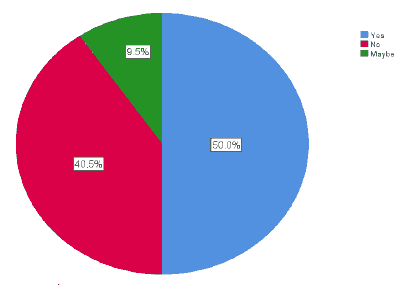
Figure 5: Pie chart showing incidence of jaw pain after waking up where blue represents yes, red represents no and green represents maybe. 50% of the total population had jaw pain after waking up in the morning.

Figure 6: Bar graph showing awareness of parents regarding treatment of bruxism where blue represents yes, red colour represents no and green colour represents maybe. 39.5% of the total participants were aware about the treatment options available. The x axis represents the awareness of participants regarding the treatment of bruxism and the y axis represents the total number of participants.
The main five components of the personality scale (extraversion, neuroticism, conscientiousness, agreeableness and openness) were compared with the incidence of clenching of teeth under stress by children. 23.3% of the children who clenched their teeth during stress mostly played on their own and 18.6% of the children who clenched their teeth played with a group of friends this shows the trait called extraversion. (Figure 7). 39.5% of the children were worried this shows the trait called Neuroticism (Figure 8), 41.9% were dependent on their parents for work this shows the trait called Conscientiousness (Figure 9), 41.9% of the children who clenched their teeth during stress were responsible this shows the trait called agreeableness (Figure 10) and 25.6% of the children were interactive with others. This shows the trait called Openness (Figure 11).
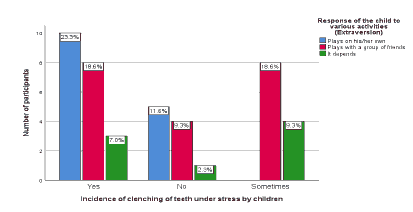
Figure 7: Bar graph showing association between clenching of teeth under stress and response of the child to various activities (Extraversion) where blue colour represents plays on his/her own, red colour represents plays with a group of friends and green colour represents it depends. The X axis shows incidence of clenching of teeth under stress by children and Y axis shows the number of participants. 23.3% of the children who clenched their teeth during stress mostly played on their own. However this was statistically significant (Pearson’s chi square test; p value=0.00 significant).
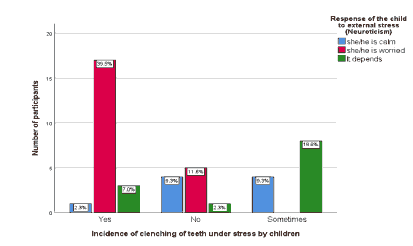
Figure 8: Bar graph showing association between clenching of teeth under stress and response of the child to extreme stress (Neuroticism) where blue colour represents she/he is calm, red colour represents she/he is worried and green colour represents it depends. The X axis shows incidence of clenching of teeth under stress by children and Y axis shows the number of participants. 39.5% of children who clenched their teeth during stress were worried. However this was statistically significant (Pearson’s chi square test; p value=0.00 significant).

Figure 8: Bar graph showing association between clenching of teeth under stress and response of the child to extreme stress (Neuroticism) where blue colour represents she/he is calm, red colour represents she/he is worried and green colour represents it depends. The X axis shows incidence of clenching of teeth under stress by children and Y axis shows the number of participants. 39.5% of children who clenched their teeth during stress were worried. However this was statistically significant (Pearson’s chi square test; p value=0.00 significant).
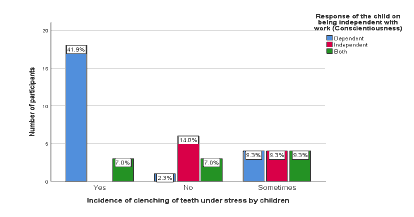
Figure 9: Bar graph showing association between clenching of teeth under stress and response of the child on being independent with work (Conscientiousness) where blue colour represents dependent, red colour represents independent and green colour represents both. The X axis shows incidence of clenching of teeth under stress by children and Y axis shows the number of participants. 41.9% children who clenched their teeth during stress were dependent on their parents for work. However this was statistically significant (Pearson’s chi square test; p value=0.00 significant).
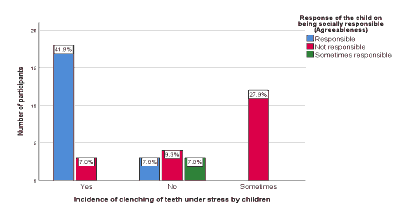
Figure 10: Bar graph showing association between clenching of teeth under stress and response of the child on being socially responsible (Agreeableness) where blue colour represents responsible, red colour represents not responsible and green colour represents sometimes responsible. The X axis shows incidence of clenching of teeth under stress by children and Y axis shows the number of participants. 41.9% children who clenched their teeth during stress were responsible. However this was statistically significant (Pearson’s chi square test; p value=0.00 significant).
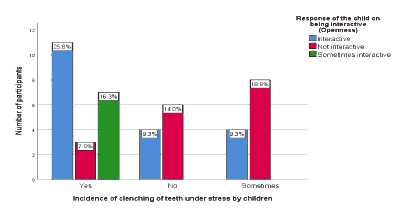
Figure 11: Bar graph showing association between clenching of teeth under stress and response of the child on being interactive (openness) where blue colour represents interactive, red colour represents not interactive and green colour represents sometimes interactive. The X axis shows incidence of clenching of teeth under stress by children and Y axis shows the number of participants. 25.6% of children who clenched their teeth during stress were interactive. However this was statistically significant (Pearson’s chi square test; p value=0.00 significant).
The present study evaluated the association between bruxism and personality of children. To test the association, parents were requested to complete a questionnaire regarding prevalence of bruxism, characteristics of their children, and the types of tasks that they performed at home. The personality traits of children were also measured. Various studies derived from sleep laboratories focus on bruxism only as a sleep-related movement disorder - grinding or clenching of teeth and do not add information or evidence to explain the possible association between bruxism and psychosocial aspects [33]. It is thus necessary to distinguish these two forms of bruxism in order to facilitate the development of experimental studies on the subject of this research. Various pathological emotional experiences more and more often result in the development of a muscular parafunction/bruxism. This can be related to occlusion or can be caused entirely by psychological stimulation. It has been proved that compulsive, controlling, and aggressive persons are more vulnerable to develop bruxism [34]. This disorder involves unconscious teeth clenching and grinding, which leads to gradual damage of the dentition and periodontium, damage of the oral mucosa, increased tension and hypertrophy of masticatory muscles, chronic headaches and cervical pain, and abnormality of the temporomandibular joints as well as hearing problems [35,36].
According to a study Bayar et al. [37], it shows that bruxism is closely connected with psychological disturbances of different degrees of severity, most of which are caused by an inability to accept everyday reality or by exaggeration of experiencing external stimuli. The studies of Bracha et al. [38] and Gungormus and Erciyas [39] distinguish from three many emotional disorders which include stress, depression, neurosis, phobias, personality disorders, anxiety, and paranoid states [40-42]. These diseases are common in highly developed societies, in which the surrounding environment directly leads to their occurrence. Chronic stress, lack of sleep, rest time, and activities are conducive to the development of psycho emotional disorders, vascular diseases, dermatological problems, gastric disturbances, and neuromuscular disorders [43-45].
Conclusion
Within the limits of this study it is conclusive that personality traits are important factors that influence bruxism among children. In our study it is found that bruxism was more commonly found during the night time, children with less social interaction, anxious behaviour and who were self dependent showed more symptoms of bruxism during their early childhood.
Acknowledgement
The study was supported by Saveetha Dental College & Hospitals, Saveetha Institute of Medical and Technical Sciences, Saveetha University, Chennai.
Conflict of Interest
There are no conflicts of interest as declared by the authors.
References
- Barbosa, de TS. Temporomandibular disorders and bruxism in childhood and adolescence: Review of the literature. Int J Pediatr Otorhinolaryngol 2008; 72: 299–314.
- Manfredini D. Prevalence of sleep bruxism in children: a systematic review of the literature. J Oral Rehabil 2013; 40:631–642.
- Lavigne GJ, Kato.T, Kolta Sessle BJ. Neurobiological MechanismsInvolved in Sleep Bruxism. Crit Rev Oral Biol Med 2003; 14:30–46.
- Holt R, Roberts G, Scully C. Dental damage, sequelae,and prevention. West J Med 2001; 174:288–290.
- Camparis CM, Siqueira JTT. Sleep bruxism: clinical aspects and characteristics in patients with and without chronic orofacial pain. Oral surgery, oral medicine, oral pathology, oral radiology, and endodontics 2006; 101:188–193.
- Kato T, Dal-Fabbro C, Lavigne GJ. Current knowledge on awake and sleep bruxism: overview. The Alpha omegan 2013; 96:24–32.
- Grechi TH, Luciana Trawitzki vv, Claudia Felicio De M, Fabiana Valera CP, Wilma Alnselmo Lima. Bruxism in children with nasal obstruction. Int J pediatr otorhinolaryngology 2008; 72:391–396.
- Ng DKK. Habitual snoring and sleep bruxism in a paediatric outpatient population in Hong Kong. Singapore med J 2002; 43:554–556.
- Restrepo CC, LM Vasquez, Alvarez M. Personality traits and temporomandibular disorders in a group of children with bruxing behaviour. J Oral Rehabil 2008; 35:585–593.
- Lobbezoo F, Van Der Zaag J, Naeije M. Bruxism: its multiple causes and its effects on dental implants - an updated review. J Oral Rehabil 2006; 33:293–300.
- Manfredini D. Anxiety symptoms in clinically diagnosed bruxers. J Oral Rehabil 2005; 32:584–588.
- Manfredini D, Lobbezoo F. Role of psychosocial factors in the etiology of bruxism. J Orofac Pain 2009; 23:153–166.
- Grist RM, Field AP. The mediating effect of cognitive development on children’s worry elaboration. J Behav Ther Exp Psychiatry 2012; 43:801–807.
- Barbaranelli C. A questionnaire for measuring the Big Five in late childhood. Pers Individ Differ 2003; 34: 645–664.
- Serra-Negra JM, Paiva SM, Ramos-Jorge ML, et al. P1- 292 Association between stress, personality traits and sleep bruxism in children: a population-based case-control study. J Epidemiol Community Health 2011; 65:A147–A147.
- Govindaraju L, Jeevanandan G, Subramanian EMG. Comparison of quality of obturation and instrumentation time using hand files and two rotary file systems in primary molars: A single-blinded randomized controlled trial. Eur J Dent 2017a; 11:376–379.
- Govindaraju L, Jeevanandan G, Subramanian EMG. Knowledge and practice of rotary instrumentation in primary teeth among indian dentists: A questionnaire survey. J Int Oral Health 2017b; 9:45-48.
- Panchal V, Gurunathan D, Shanmugaavel AK. Smartphone application as an aid in determination of caries risk and prevention: A pilot study. Eur J Dent 2017; 11:469–474.
- Ravikumar D, Jeevanandan G, Subramanian EMG. Evaluation of knowledge among general dentists in treatment of traumatic injuries in primary teeth: A cross-sectional questionnaire study. Eur J Dent 2017; 11:232–237.
- Jeevanandan G, Govindaraju L. Clinical comparison of Kedo-S paediatric rotary files vs manual instrumentation for root canal preparation in primary molars: a double blinded randomised clinical trial. Eur Arch paediatr Dent 2018; 19:273–278.
- Nair M. Comparative evaluation of post-operative pain after pulpectomy with k-files, kedo-s files and mtwo files in deciduous molars -a randomized clinical trial. Braz Dent Sci 2018; 21:411.
- Ravikumar D. Evaluation of McNamara’s analysis in South Indian (Tamil Nadu) children between 8-12 years of age using lateral cephalograms. J Oral biol Craniofac Res 2018; 9:193–197.
- Ravindra V, Vishnu Rekha C. A comparative evaluation between dermatoglyphic patterns and different terminal planes in primary dentition. J Clin Exp Dent 2018; 10: e1149–e1154.
- Ravindra V. A comparative evaluation between cheiloscopic patterns and the permanent molar relationships to predict the future malocclusions. J Clin Exp Dent 2019; 11:e553–e557.
- Subramanyam D, Priya V, Gaayathri R, et al. Comparative evaluation of salivary malondialdehyde levels as a marker of lipid peroxidation in early childhood caries. Eur J Dent 2018; 12:67–70.
- Vishnu Prasad S, Madan Kumar, Ramakrishnan M, et al. Report on oral health status and treatment needs of 5-15 years old children with sensory deficits in Chennai, India. Special care in dentistry: official publication of the American Association of Hospital Dentists, the Academy of Dentistry for the Handicapped. American Society for Geriatric Dentistry 2018; 38:58–59.
- Jeevanandan G, Ganesh S. Arthilakshmi. Kedo file system for root canal preparation in primary teeth. Indian J Dent Res 2019; 30:622–624.
- Ramadurai N. Effectiveness of 2% Articaine as an anesthetic agent in children: randomized controlled trial. Clin Oral Investig 2018; 23:3543–3550.
- Panchal V, Jeevanandan G, Subramanian E. Comparison of instrumentation time and obturation quality between hands K-file, H-files, and rotary Kedo-S in root canal treatment of primary teeth: A randomized controlled trial. J Indian Soc Pedod Prev Dent 2019; 37:75–79.
- Vignesh R, Sharmin D, Sharmin D, et al. Management of Complicated Crown-Root Fracture by Extra- Oral Fragment Reattachment and Intentional Reimplantation with 2 Years Review. Contemp Clin Dent 2019; 10:397–401.
- Panchal V, Jeevanandan G, Subramanian EMG. Comparison of post-operative pain after root canal instrumentation with hand K-files, H-files and rotary Kedo-S files in primary teeth: a randomised clinical trial. Euro Arch Paediatr Dent 2019; 20:467–472.
- Samuel SR, Acharya S and Rao JC. School Interventions-based Prevention of Early-Childhood Caries among 3-5-year-old children from very low socioeconomic status: Two-year randomized trial. J Public Health Dent 2020; 80:51–60.
- Manfredini D, Lobbezoo F. Role of psychosocial factors in the etiology of bruxism. J Orofac Pain 2009; 23:153–166.
- Takemura T. A psychological study on patients with masticatory muscle disorder and sleep bruxism. Cranio: the journal of craniomandibular practice 2006; 24:191–196.
- Goncalves DA, Camparis CM, Speciali JG, et al. (2011) Temporomandibular Disorders Are Differentially Associated with Headache Diagnoses: a controlled study. Clin J Pain 2011; 27:611–615.
- Rossi De SS, Stern I, Sollecito TP. Disorders of the Masticatory Muscles. Dent Clin North Am 2013; 57:449–464.
- Bayar GR, Tutuncu R, Acikel C. Psychopathological profile of patients with different forms of bruxism. Clin Oral investig 2012; 16:305–311.
- Bracha HS, Tyler CR, Andrew EW, et al. The Clenching-Grinding Spectrum and Fear Circuitry Disorders: Clinical Insights from the Neuroscience/ Paleoanthropology Interface. CNS Spectrums 2005; 10:311–318.
- Gungormus Z, Erciyas K. Evaluation of the relationship between anxiety and depression and bruxism. J Int Med Res 2009; 37:547–550.
- Alterman AI. Relationship of Mental Health and Illness in Substance Abuse Patients. Pers Individ Dif 2010; 49: 880–884.
- Lv X, Han D, Xi L, et al. Psychological aspects of female patients with moderate-to-severe persistent allergic rhinitis. ORL J otorhino-laryngology Relat Spec 2010; 72:235–241.
- Van Houdenhove B, Kempke S, Luyten P. Psychiatric aspects of chronic fatigue syndrome and fibromyalgia. Curr Psychiatry Rep 2010; 12:208–214.
- Bellini M. Self-assessed bruxism and phobic symptomatology. Minerva stomatologica 2011; 60:93–103.
- Manfredini D. Psychic and occlusal factors in bruxers. Aust Dent J 2008; 49: 84–89.
- Ramakrishnan M, Dhanalakshmi R, Subramanian EMG. Survival rate of different fixed posterior space maintainers used in Paediatric Dentistry - A systematic review. Saudi Dent J 2019; 31:165–172.
Author Info
Deepa Gurunathan1*, Mahesh Ramakrishnan2, Joyson Moses3, Nivedhitha MS4 and Meghana Reddy J5
1Department of Pedodontics, Saveetha Dental College and Hospitals, Saveetha University Tamilnadu, India2Department of Pediatric and Preventive Dentistry, Saveetha Dental College and Hospitals, Saveetha Institute of Medical and Technical Sciences, Saveetha University, Chennai, India
3Department of Pediatric and Preventive Dentistry, Thai Moogambigai Dental College and Hospital, Mogappair, Chennai, India
4Department of Conservative Dentistry and Endodontics, Saveetha Dental College and Hospitals, Saveetha Institute of Medical and Technical Sciences, Saveetha University, Tamilnadu, India
5Saveetha Dental College and Hospitals, Saveetha Institute of Medical and Technical Sciences, Saveetha University, Chennai, India
Citation: Deepa Gurunathan, Mahesh Ramakrishnan, Joyson Moses, et al. Influence of Type of Personality and Bruxism in Children, J Res Med Dent Sci, 2021, 9(S1): 19-24.
Received: 23-Feb-2021 Accepted: 10-Mar-2021 Published: 17-Mar-2021
Sources of funding : GB´s PhD-project on ethical challenges and decision-making in nursing homes has been financially supported by the Norwegian Extra Foundation for Health and Rehabilitation through EXTRA funds (grant no. 2008/2/0208).
